

24830 views
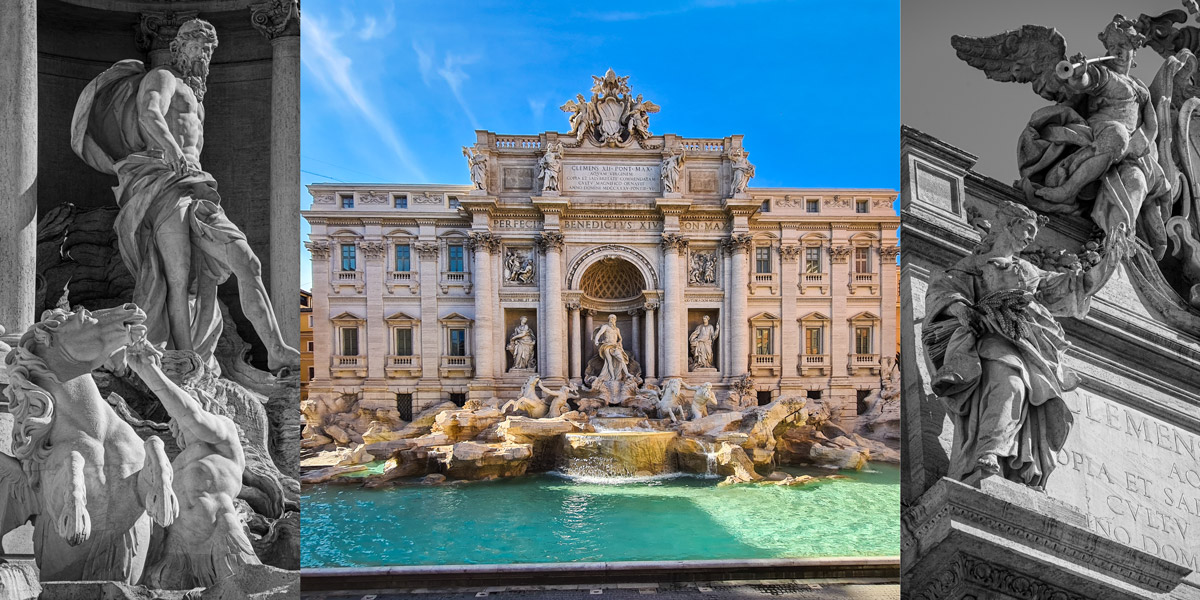
| Tip | Visit Trevi Fountain early morning or evening for fewer crowds. Enjoy the iconic coin-tossing tradition, but remember, entering the water is prohibited. Explore nearby streets and cafes for a complete experience. |
|---|---|
| Recommended tour | |
| Closest bus stops |
|
| Closest subway stations |
|
| Address | Piazza di Trevi, Roma |
| Website | www.turismoroma.it |
The Trevi Fountain (Italian: Fontana di Trevi) is Rome’s most iconic Baroque masterpiece, standing out as a true gem among the city’s hundreds of fountains. Majestic and theatrical, it evokes the grandeur of an ancient play carved in stone rather than merely a source of clean water. Thanks to its impressive scale, central location, and breathtaking beauty, the fountain draws millions of visitors to Italy’s capital each year.
Contents
ToggleTo fully appreciate the grandeur of the Trevi Fountain, it’s essential to understand the symbolism behind each beautifully carved figure and detail. Let’s explore the fountain step-by-step, from top to bottom, uncovering stories that will enrich your visit.
Use this guide as your reference while standing before the Trevi Fountain, connecting deeply with its artistry and legends.
At the very top, you’ll notice a grand sculptural group crowned by the unmistakable Papal Tiara, symbolizing the Pope’s supreme authority. Below the tiara are two crossed keys representing Saint Peter’s keys to Heaven—another reference to papal power.
Interestingly, the central shield lacks a detailed coat of arms, suggesting the fountain’s universal significance, belonging to all Romans rather than a single pope.
Flanking the shield, two angels blow trumpets, symbolizing Fame and celebrating Pope Clement XII, who commissioned the fountain. These figures, sculpted by Paolo Benaglia, perfectly showcase the Baroque movement and drama.
Beneath the Papal Tiara, a prominent Latin inscription commemorates Pope Clement XII’s patronage:
CLEMENS XII PONT. MAX.
AQUAM VIRGINEM COPIA ET SALUBRITATE COMMENDATAM
CULTU MAGNIFICO ORNAVIT
ANNO DOMINI MDCCXXXV PONTIF. VI
Translated, it reads:
“Clement XII, Supreme Pontiff, adorned the Aqua Virgo—praised for its abundance and healthfulness—with magnificent decoration, in the year of the Lord 1735, the sixth year of his pontificate.“
Four allegorical statues surround this inscription, each sculpted by Andrea Bergondi and symbolizing Rome’s virtues:
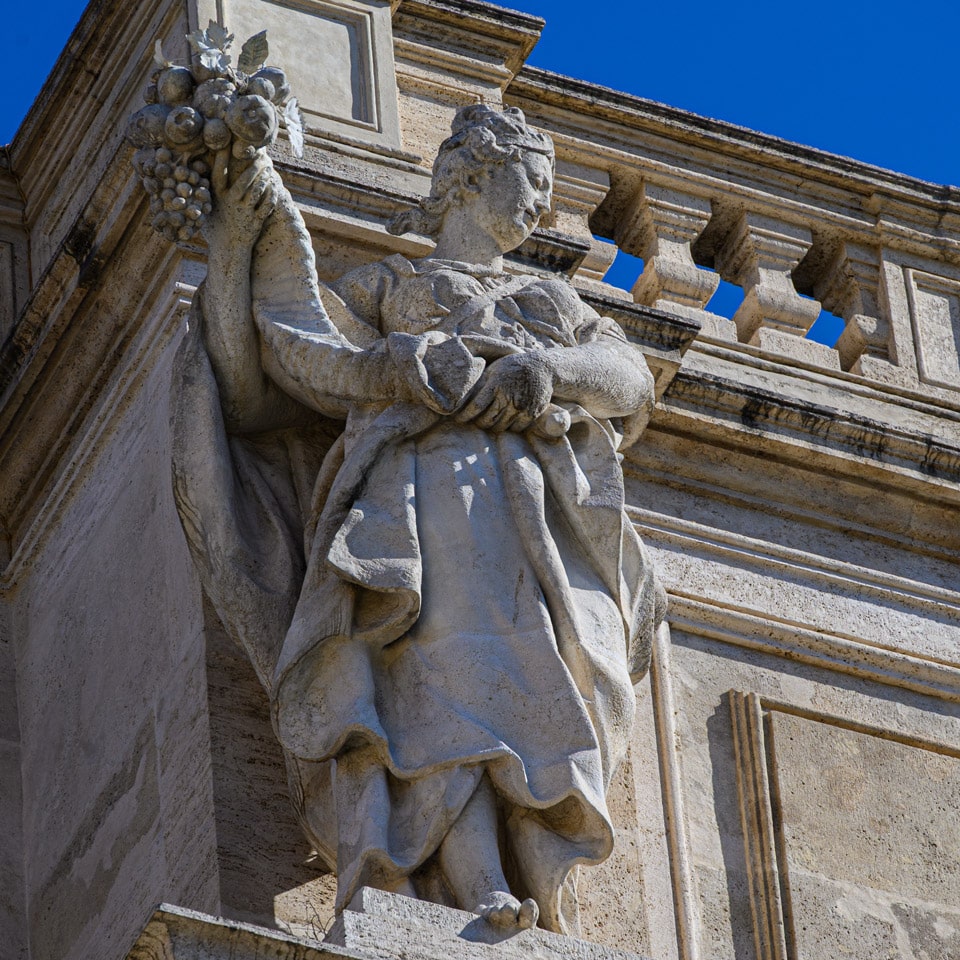
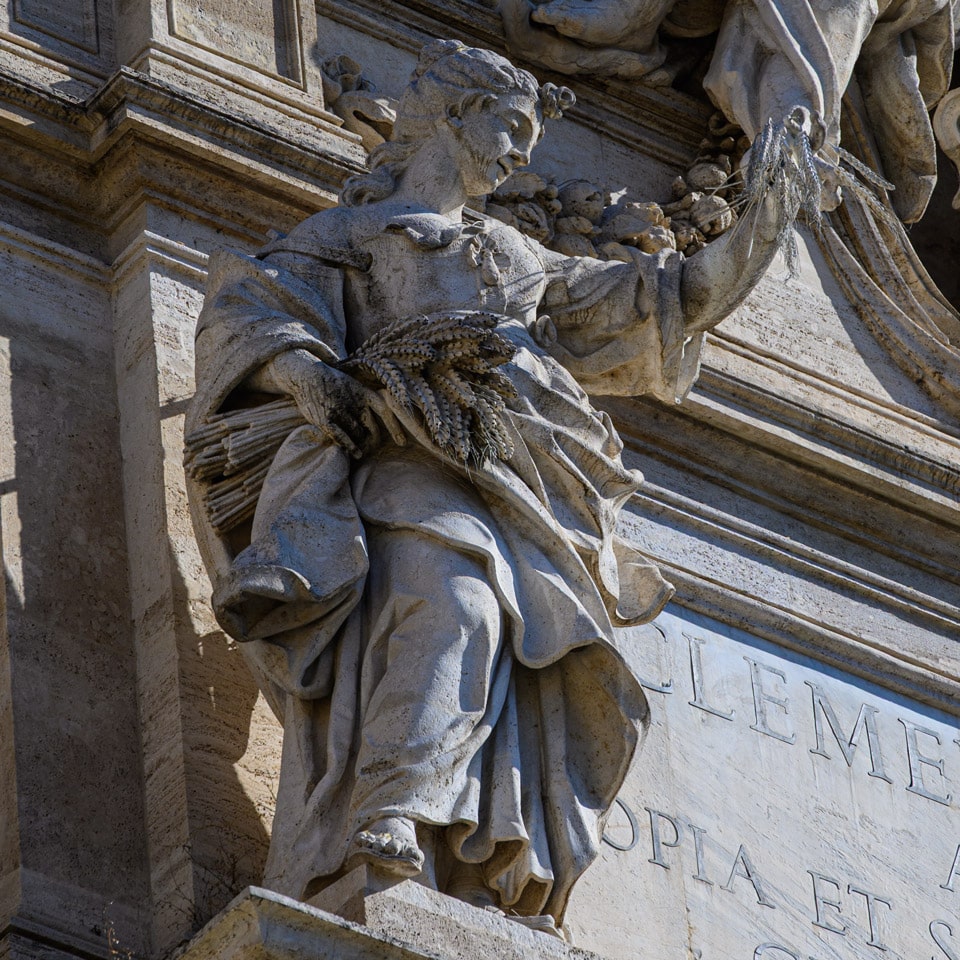
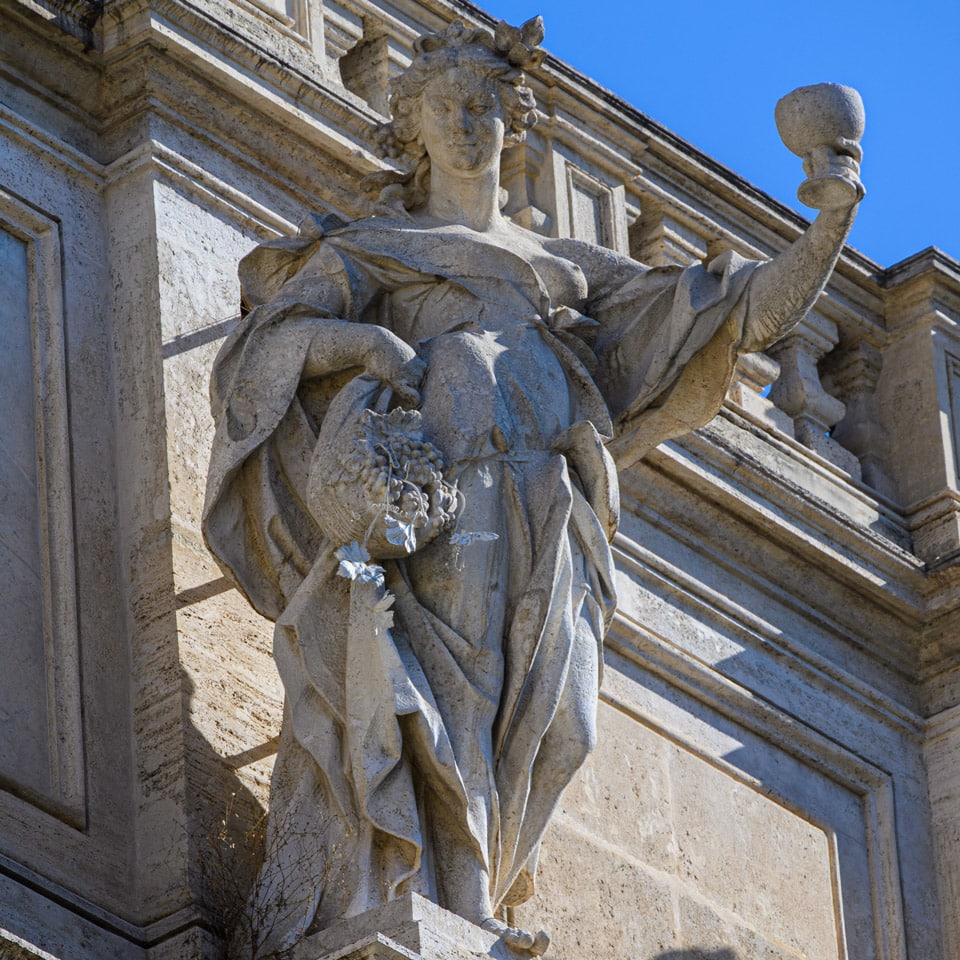
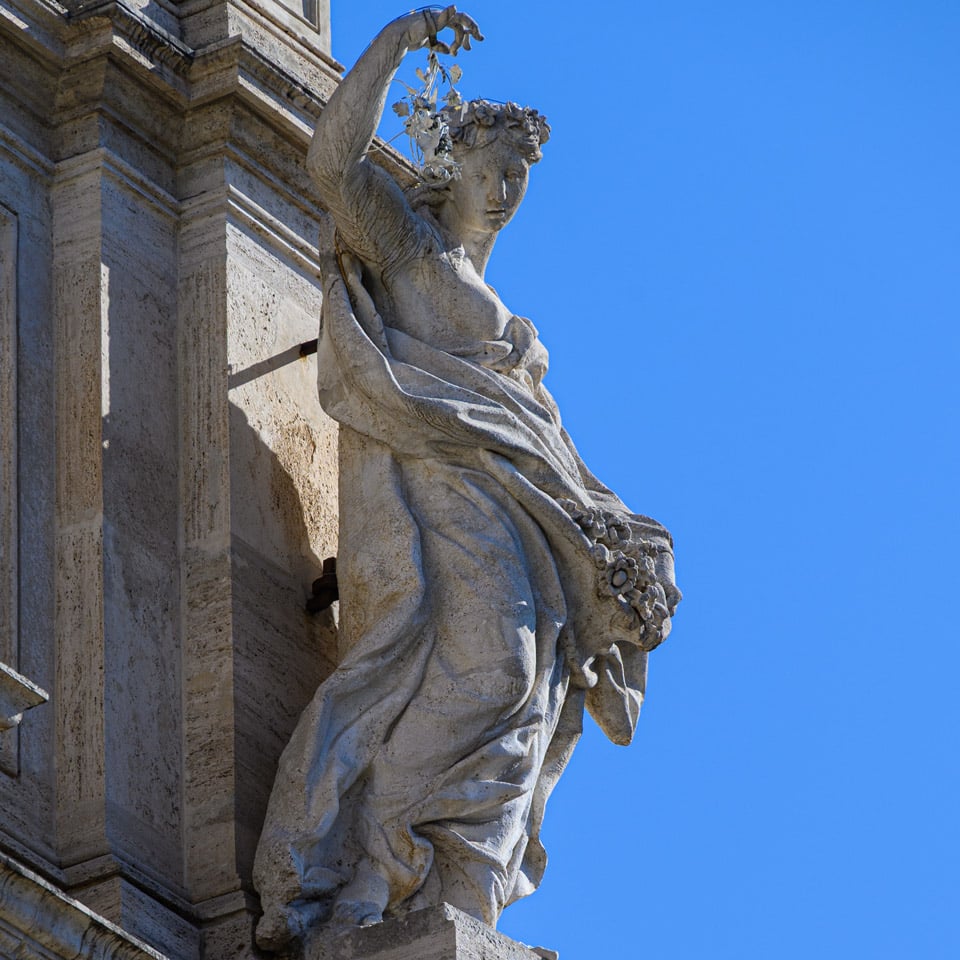
Together, they celebrate the Aqua Virgo aqueduct’s role in bringing health and prosperity to Rome.
Below Clement XII’s inscription, a second Latin text honors Pope Benedict XIV, who completed the project:
PERFECIT BENEDICTUS XIV PON. MAX.
This translates simply to:
“Benedict XIV, Supreme Pontiff, completed this work.“
Pope Benedict XIV ensured funding and construction continued after Clement XII’s death, finalizing this iconic monument.
On the left, a detailed bas-relief sculpted by Giovan Battista Grossi captures General Agrippa approving plans for the Aqua Virgo aqueduct in 19 BC. Agrippa confidently examines plans presented by an engineer, symbolizing Rome’s ambitious engineering achievements.
On the right, another bas-relief by Andrea Bergondi portrays the legendary scene of a young maiden (“virgo”) guiding Roman soldiers to the pure water source, highlighting the aqueduct’s mythical origin and giving it the name “Aqua Virgo.”
The heart of the fountain features Oceanus, a powerful Titan deity who represents all oceans.
He rides a shell-shaped chariot pulled by two seahorses—one calm, one wild—each guided by Tritons, symbolizing the sea’s contrasting moods. Sculpted by Pietro Bracci, the scene masterfully embodies the Baroque style’s dramatic energy.
Above Oceanus, another Latin inscription states:
POSITIS SIGNIS ET ANAGLYPHIS TABULIS IUSSU CLEMENTIS XIII PONT. MAX. OPUS CUM OMNI CULTU ABSOLUTUM A.D. MDCCLXII
This translates as:
“The statues and reliefs having been placed, the work was completed by order of Clement XIII, Supreme Pontiff, in the year of the Lord 1762.“
To the left of Oceanus is Abbondanza, Goddess of Abundance, sculpted by Filippo della Valle. She gently holds a cornucopia, symbolizing prosperity and nourishment provided by the aqueduct.
Central to the fountain stands Oceanus, majestically portrayed stepping forward. This represents water’s immense power and essential life-giving role.
Opposite Abbondanza, also sculpted by Filippo della Valle, stands Salubrità, the Goddess of Health. She holds a spear and a bowl from which a snake drinks, symbolizing the healing and purity of the fountain’s waters.
Below Oceanus, on the left, a mighty Triton struggles to control a wild seahorse, symbolizing the stormy, unpredictable sea—another dramatic work by Pietro Bracci.
On the right, a calmer Triton blows a conch shell, guiding a serene seahorse to represent the tranquil, nurturing side of the ocean, creating a striking contrast.
Together, these elements harmoniously celebrate Rome’s relationship with water, emphasizing both its beauty and power, bringing history, mythology, and artistry vividly to life in one of Rome’s most famous monuments.
The Trevi Fountain, constructed in the 18th century, has an intriguing history that stretches back to ancient Roman times. Its origins date to around 19 BC, during the reign of Emperor Augustus, when his trusted associate, Marcus Vipsanius Agrippa, began a significant reorganization of Rome’s water supply system. Among Agrippa’s notable achievements was constructing the Aqua Virgo aqueduct, which was designed to supply pure drinking water to the city’s residents.
The Aqua Virgo, named poetically for its remarkably pure waters, stretched approximately 12 kilometers (about 7.5 miles) and provided fresh, clean water to the ancient Romans for centuries.
Up until the early 17th century, visitors to Trevi Square (Italian: Piazza di Trevi) could still quench their thirst from a simple spring that flowed into a stone basin. Pope Urban VIII decided the city deserved something grander. He commissioned the celebrated Baroque architect Gian Lorenzo Bernini to design an impressive fountain for the square.
The original design of the fountain was envisioned by the famed artist Gian Lorenzo Bernini. However, the death of Pope Urban VIII in 1644 halted progress, and Bernini’s plans remained unrealized. It wasn’t until the early 1700s that the project was revived under Bernini’s apprentice, Carlo Fontana. Fontana preserved Bernini’s initial Baroque concepts but adapted them to incorporate more classical elements, emphasizing balance and harmony.
Fontana’s updated design prominently featured a grand sculpture of Oceanus (often mistakenly called Neptune) accompanied by Tritons and mythological sea creatures, symbolizing the power of the ocean.
Following Carlo Fontana’s death in 1714, the project again experienced a lengthy interruption. It wasn’t until Pope Clement XII organized a prestigious competition in 1730 to select a new chief architect that the fountain’s fate was finally sealed. Nicola Salvi emerged victorious among sixteen renowned architects, securing the opportunity to bring to life an extraordinary masterpiece that would both astonish visitors and seamlessly blend into the architectural landscape of Trevi Square.
Salvi faced the daunting challenge of creating a fountain that was not only grandiose and awe-inspiring but also harmoniously integrated with the Palazzo Poli behind it. His ambitious vision materialized in a majestic display of Baroque art and architecture, marking one of Rome’s most iconic landmarks.
Standing at Trevi Square today, visitors might not immediately realize that Palazzo Poli and the Trevi Fountain form one harmonious architectural complex. Architect Nicola Salvi masterfully integrated these two elements, creating a stunning composition of dynamic sculptures that continue to captivate visitors centuries later.
The Trevi Fountain took 30 years to build—from 1732 to 1762. By completion, an awe-inspiring scene of Oceanus emerging dramatically from the waters appeared against Palazzo Poli’s Baroque facade. Salvi brilliantly conveyed movement and energy, making it easy for spectators to imagine Oceanus’ chariot bursting forth amid waves and splashes.
Today, guests from around the globe visit Rome’s most famous fountain to admire its grandeur and to take part in a beloved ritual: tossing coins into its waters.
According to tradition, tossing coins into the fountain ensures specific blessings:
To make your wish correctly, stand with your back to the fountain and toss your coin using your right hand over your left shoulder.
The daily coin tosses add up quickly. On average, visitors leave approximately €1,500 each day—amounting to more than €1 million every year! The collected coins are donated regularly to Caritas Roma, a charitable organization helping Rome’s neediest residents.
To witness a unique aspect of the fountain’s upkeep, stop by early on Monday mornings (around 8 AM).
City workers drain and carefully clean the fountain, collecting the thousands of coins left by hopeful visitors during the week.
Watching this meticulous maintenance offers an intriguing behind-the-scenes glimpse into how Rome preserves one of its most cherished landmarks.
The name “Trevi Fountain” has inspired several intriguing legends and interpretations. The most commonly accepted explanation links the name to its location at the intersection of three major Roman streets. Indeed, experts agree that the Italian word trevi derives from the Latin trivium, meaning “junction of three roads.”
A charming alternative legend speaks of a young woman named Trivia who guided ancient Roman builders to a hidden spring of exceptionally pure drinking water. The spring later fed the Aqua Virgo aqueduct, which supplied the fountain.
From June 2014 to November 2015, the fountain was officially closed to visitors because of reconstruction procedures. The reason for that was the decay of stone constructions, daily necking down by the water streams, and crowds of tourists. Needless to say, the last reconstruction occurred about 125 years ago. It was a close call when, in 2014, superb sculptures started losing some of their parts, and emergency repair was organized immediately.
However, the fashion house “Fendy” took a particular interest in the reconstruction of the famous fountain. According to approximate estimates, two million and 200 thousand Euro were needed for the renovation of the monument of art.
See my tips about What to See in 3 days and the Top 15 Free Things to Do in Rome.
Hotels offering direct views of the Trevi Fountain are limited, highly sought-after, and tend to book up quickly—especially during peak tourist seasons. If you dream of waking up to the iconic fountain right outside your window, we strongly recommend reserving your stay as early as possible.
Here are three top options offering unforgettable views:
The distance from the Spanish Steps to the Trevi Fountain is only 650 meters (0.4 miles). You can walk it in just 8 minutes.
As a local expert, I recommend a more exciting and self-guided sightseeing route:
The length of such an informative and beautiful route is only 1.5 miles. Considering visits to churches and photographs against the backdrop of attractions, the walk will take about 1 hour.
The Trevi Fountain is located in the region called Trevi, and the Colosseum in the Monti region, the distance between them is 1 mile (1.6 km). You can walk it in just 20 minutes.
Below is a more exciting and self-guided sightseeing route from Trevi Fountain to Colosseum:
The route is 3.3 miles (5.3 km) long, and the walk, including sightseeing, will take approximately 2 hours.
If you want a private tour or get advice on planning a vacation, please contact me through the contact form.
I wish you a perfect holiday in Rome.
Author: Artur Jakucewicz
This website uses cookies. For more info read the cookies policy
Rome.us © 2025. Created with love by Roman experts and guides.